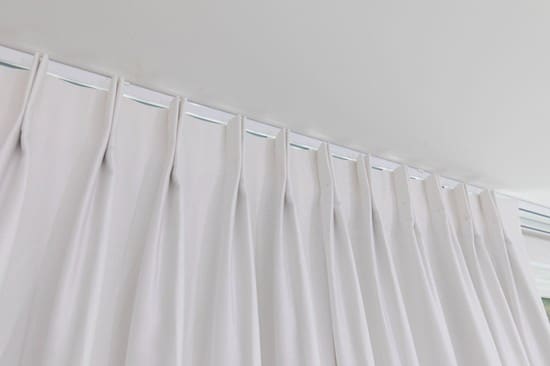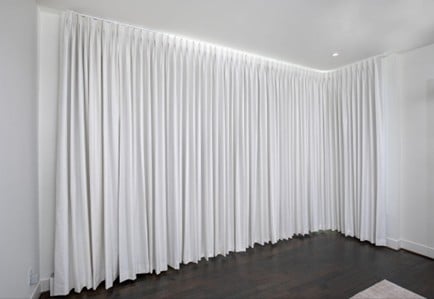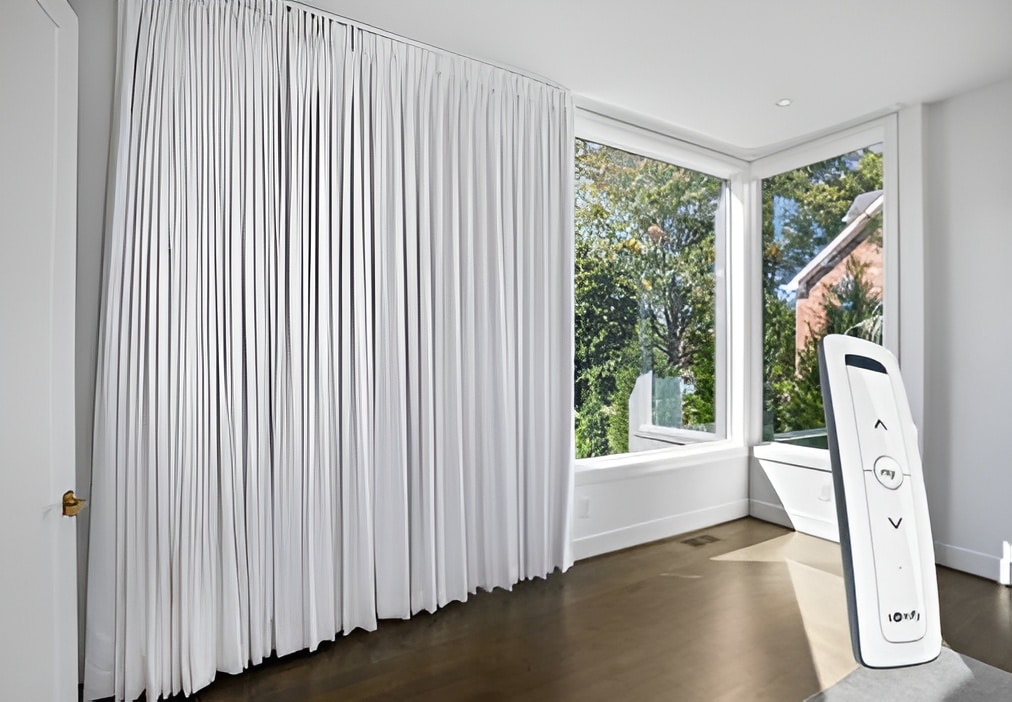If you’ve ever wanted to close your drapes without getting up—or better yet, control them while you’re away from home—motorized drapery might be the solution. This smart window treatment option blends traditional elegance with modern convenience, allowing you to automate how and when your drapes open and close.
What Is Motorized Drapery?
Motorized drapery refers to a curtain system that opens and closes using an electric motor instead of manual pull cords or rods. The drapes are mounted on a track system that contains a quiet motor, typically hidden behind the fabric or ceiling-mounted for a seamless look. You can control the system in several ways: using a remote control, a smartphone app, or by integrating it with voice assistants like Amazon Alexa, Google Assistant, or Apple HomeKit.

A pinch pleat motorized drapery system discreetly blends into the ceiling line for a sleek, modern look.
Some systems even allow for scheduling—so your drapes can automatically open with the sunrise and close at sunset—no reminders or buttons necessary.
How It Benefits Your Home
The most obvious benefit is convenience. You can operate your window treatments with a simple tap or command, which is especially helpful for hard-to-reach windows or heavy drapes. But motorization also contributes to home efficiency and aesthetics.
For example, by programming your drapes to close during the hottest part of the day, you can block out solar heat and protect your furniture, floors, and artwork from UV damage. In colder months, closing the drapes at night helps insulate your windows, reducing heat loss and lowering energy costs.
From a design standpoint, motorized drapery eliminates the need for dangling cords or bulky hardware, creating a cleaner, more streamlined look. This also makes them a safer choice for households with children or pets.

Motorized drapery is both functional and family-friendly, with no cords or chains in sight.
Powering Options
Motorized drapery systems offer flexible power and wiring options to suit different home setups and renovation stages. The most straightforward solution is a plug-in system, which simply connects to a nearby outlet—ideal for quick installations and spaces where outlets are easily accessible. However, visible cords can detract from a clean design and may limit placement if outlets aren’t conveniently located. For a cleaner, cordless look, battery-powered motors are a popular choice, especially in retrofit installations or areas where wiring is difficult to conceal. Keep in mind that batteries require periodic recharging or replacement and may not be ideal for heavy or frequently used drapes. For a more permanent and seamless solution, hardwired systems are often preferred in new construction or major remodels. These are integrated into the home’s electrical system, eliminating the need for charging or visible cords, but they do require an electrician for installation and are best planned early in the design process, as they are not easily moved once installed.
Where It Works Best
Motorized drapes are especially useful in rooms with large or hard-to-reach windows—like two-story foyers or tall living room windows—where adjusting them manually would be inconvenient. They’re also popular in bedrooms for their ability to block light on command, and in media rooms where a single tap can darken the space for movie night. In open-concept living spaces, they provide an elegant, tech-savvy solution that enhances both function and appearance.
Is Motorized Drapery Right for You?
If you’re looking for a blend of technology, comfort, and design, motorized drapery can be a smart investment. While the upfront cost is higher than traditional options, many homeowners find the long-term benefits—like energy savings, automation, and improved safety—well worth it.
Before deciding, it’s helpful to explore fabric choices, track system styles, and compatibility with your smart home setup. A professional can help guide you through the options to ensure the final result enhances both your lifestyle and your space.

